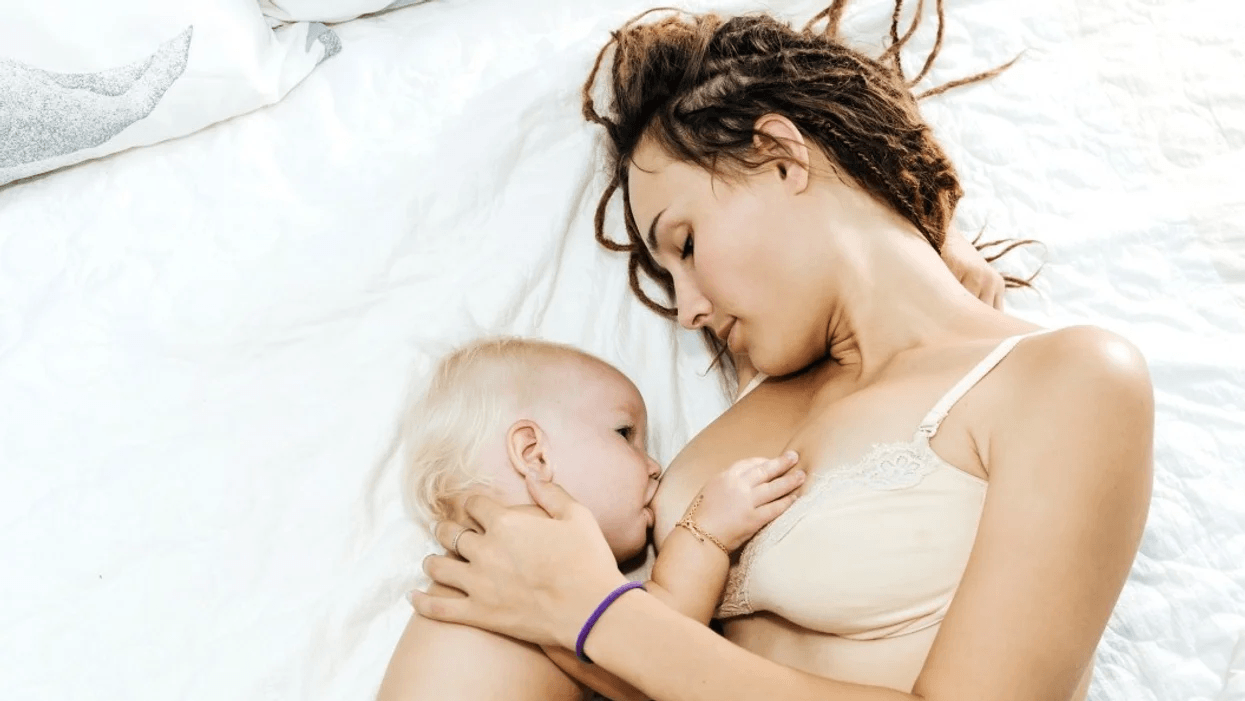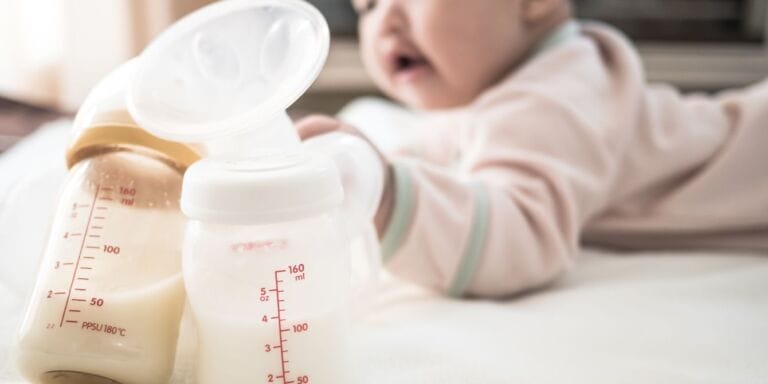Does bed-sharing increase the risk of SIDS? If you breastfeed, new study says no

A new report from the Academy of Breastfeeding Medicine states that the information we currently have on safe sleep may be more nuanced than we realize.
Table of Contents
The American Academy of Pediatrics (AAP) has been incredibly vocal about safe sleep, urging parents not to share a bed with their baby and to follow guidelines that will decrease the risk of Sudden Infant Death Syndrome, or SIDS.
But a new report from the Academy of Breastfeeding Medicine states that the information we currently have on safe sleep may be more nuanced than we realize. The authors call for further research and more individualized counseling of parents.
According to the study authors, when babies are breastfed in the home setting, and in the absence of other risk factors, current research does not find that bed-sharing increases the risk of SIDS. The study was co-authored by James McKenna, Ph.D., a professor who studies co-sleeping, and the director of the Mother-Baby Behavioral Sleep Laboratory at the University of Notre Dame.
Study authors write that it’s possible bed-sharing may be beneficial for exclusively breastfed babies in the prevention of SIDS. “When breastfeeding mothers sleep with their infants, they protect them from potential physiological stressors including airway covering and overheating by their characteristic sleep position (curled around their infants, making a constrained sleep space with their bodies), known as the C-position,” they state. “Their continued vigilance through microarousals prompts regular infant arousals throughout the night.”
Additionally, “compared with breastfeeding infants who sleep alone, breastsleeping infants spend less time in stages [three to four] (deep) sleep, and more time in stages [one to two] (lighter) sleep, facilitating rapid infant awakening and termination of apneas,” they write, arguing this could result in a decreased risk of SIDS.
The study authors report that “Existing evidence does not support the conclusion that bed-sharing among breastfeeding infants (i.e., breastsleeping) causes sudden infant death syndrome (SIDS) in the absence of known hazards.”
They argue that the medical community needs to re-examine generalized recommendations on safe sleep because different factors—in this case, whether or not a baby is breastfed—can change the risk factor. “Recommendations concerning bed-sharing must take into account the mother’s knowledge, beliefs, and preferences and acknowledge the known benefits as well as the risks.”
SIDS is the sudden death of an infant under the age of one, with no immediate apparent cause—though sometimes accidental suffocation and strangulation are identified as the cause. Approximately 3,600 babies die each year in the United States from SIDS.
AAP suggests parents follow these safe sleep guidelines to prevent SIDS:
- Infants should sleep on their backs
- Infants should sleep on a firm sleep surface
- Breastfeeding is recommended
- Infants should sleep on their own sleep surface in the parents’ room for the first six to 12 months of life
- Nothing in the cribs with babies, including blankets and other loose bedding, pillows, toys, and bumpers
- Pacifier may help
- Avoid cigarette smoke during pregnancy and around the baby
- Avoid alcohol and drug use during pregnancy
- Avoid overheating and head covering of infant
- Get regular prenatal care
- Infants should receive vaccines per AAP and Centers for Disease Control recommended timeline
- Do not use commercial devices that are inconsistent with sleep recommendations
- Avoid the use of at-home cardiorespiratory monitors unless designated by your pediatrician
- Use tummy time to strengthen baby’s muscles
The AAP is very adamant that parents practice room-sharing, not bed-sharing.
However, McKenna’s study and other breastsleeping advocates are arguing for two action items: More research and better education.
We need to learn more about SIDS in the presence and absence of specific variables so that we can counsel parents based on the specifics of their unique circumstances. “Larger studies with appropriate controls are needed to understand the relationship between bed-sharing and infant deaths in the absence of known hazards at different ages,” the researchers notes.
They argue that we need to teach people how to safely bedshare: “Despite decades of advice to avoid mother-infant sleep contact, researchers report that on any given night, 20–25% of U.S. and U.K. infants [less than three} months of age share a bed with a parent for sleep at least some of the nights, and [more than] 40% of infants in Western societies, in general, do so at some point in the first [three] months.”
This means that regardless of intent, there is a good chance parents will fall asleep with their babies—that is why researchers continue to investigate the safest ways to do it.
According to the Mother-Baby Behavioral Sleep Laboratory, guidelines for the safest possible bed-sharing are as follows:
- Prenatal care and avoidance of prenatal exposure to cigarette smoke
- Infants should always sleep on their backs
- Infants should sleep on a firm surface
- Avoid infant exposure to cigarette smoke
- Blankets on ed should be light, and their heads should never be covered.
- “The bed should not have any stuffed animals or pillows around the infant and never should an infant be placed to sleep on top of a pillow or otherwise soft bedding.”
- “Sheepskins or other fluffy material and especially beanbag mattresses should never be used with infants. Waterbeds can be especially dangerous to infants too, and no matter the type of mattress, it should always tightly intersect the bed-frame to leave no gaps or space.”
- “Infants should never sleep on couches or sofas with or without adults as they can slip down (face first) into the crevice or get wedged against the back of a couch where they may suffocate.”
- Bottle-fed babies should not bedshare
- If there are two parents in the bed, “both parents should agree and feel comfortable with the decision. Each bed-sharer should agree that he or she is equally responsible for the infant and acknowledge before sleeping that they are aware that the infant is present in the bed space. Do not place an infant in the bed with a sleeping adult who is not aware that the infant is in the bed with them.”
- Infants should not sleep with other children in the bed
- bed-sharing should not take place if either adult is “taking sedatives, medications or drugs, or intoxicated from alcohol or other substances, or otherwise excessively unable to arouse easily from sleep.”
- If either adult has very long hair, it should be tied up to prevent infant entanglement around the infant’s neck.
- “Extremely obese persons or others who may have difficulty feeling where exactly or how close their infant is in relation to their own body may wish to have the infant sleep alongside but on a different surface, such as a cosleeper attachment.”
Lastly, they state, “it may be important to consider or reflect on whether you would think that you suffocated your baby if, under the most unlikely scenario, your baby died from SIDS while in your bed. Just as babies can die from SIDS in a risk-free solitary sleep environment, it remains possible for a baby to die in a risk-free co-sleeping/bed-sharing environment.” In other words, they want parents to know that no matter what protections are taken, SIDS can be a possibility—they ask you to consider what it would feel like if it happened while bed-sharing. “While this is an unpleasant and uncomfortable topic, it is one that is worth thinking about before you choose to co-sleep/bed-share with your infant.”
So what does this mean for you, mama?
Do your research and speak with your child’s pediatrician. Our lives are incredibly complex, and there are thousands of factors that contribute to the parenting decisions we make (and the choices we have to begin with). I absolutely advise adhering to safe sleep practices—the really tricky part is that experts disagree on what that means entirely. So, schedule a conversation with your provider and other experts to discuss what’s on your mind.
[Editor’s note: This article summarizes findings and recommendations of a recent study, and should not substitute the advice of a medical provider.]





































